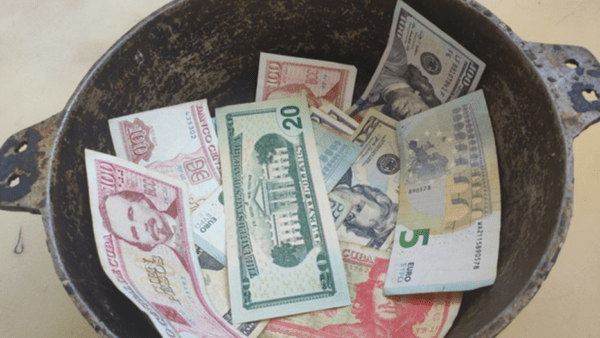The US Dollar Breaks a New Record in Cuba

HAVANA TIMES – The US dollar set a new record in Cuba on Monday by trading at 275 pesos on the informal foreign exchange market, which deepens the strong depreciation of the local currency since the economic reform of 2021.
This new maximum – recorded by the independent media El Toque – comes after the announcement, in mid-December, of a large macroeconomic adjustment program by the Cuban Government.
Among the measures announced, such as the increase of 500% in the price of gasoline and diesel, is the implementation of a new official exchange rate, which since 2021 stands at 24 pesos per dollar (1.045% lower than the informal rate) for companies and 120 for individuals (129% lower than on the black market).
A few days after Prime Minister Manuel Marrero announced the plan in Parliament, the informal rate registered a slight drop to reach 265 pesos per dollar. But in 2024 it has risen again to the levels prior to the announcement, until it broke the record this Monday.
The need to import 80% of what the country consumes, the strong migratory pressure and the uncertainty due to the serious crisis are some of the main factors that explain the current partial dollarization of the Cuban economy and the consequent depreciation of the Cuban peso.
The Government has recognized on several occasions the failures in the design and implementation of the 2021 reform, called the OrderingTask,* which has not met the objectives of ending the monetary duality of the Island, which used the national currency and the convertible peso (CUC), equivalent to the dollar.
Many people stock up on dollars in the informal market due to restrictions on buying them at state exchange offices, where only up to 100 units of the US currency are sold per person per day, and only if there is availability.
The El Toque index – harshly criticized by the Government for stirring up “speculation” – takes as a reference about 2,000 daily ads for the sale of foreign exchange on several Cuban websites to establish its reference exchange rate, according to this independent media.
In the absence of another type of official indicator, this index has become the benchmark on the street and for economists who study the situation in the country.
*Translator’s note: The Ordering Task is a collection of measures that include eliminating the Cuban Convertible Peso (CUC), leaving the Cuban peso (CUP) as the only national currency, raising prices, raising salaries (but not as much as prices), opening stores that take payment only in hard currency, which must be in the form of specially issued pre-paid debit cards, and a broad range of other measures targeted to different elements of the Cuban economy.
Translated by Regina Anavy for Translating Cuba.






I have every reason to believe my Cuban family and friends in La Habana who say high-class restaurants openly print menus with prices in MLC and Euros. Likewise, if a customer wants to pay in USD, they can do so without issue. Think about that, while at the same time the Castro dictatorship officially makes it illegal to use American dollars to make purchases, it openly turns a blind eye to these dollars circulating in the streets. Geez, every day it seems like there’s more bad news from the Castro regime. If this isn’t an example of death by a thousand cuts, what is?
In Cuba in 2024, even though its totalitarian government considers it an antithesis to its Revolutionary ideals, small businesses are flourishing. In order to compete in the small business world, business enterprises are competing among themselves for Cuban customers. In a free market economy on a Cuban street that is a good thing.
To do so these enterprising entrepreneurs must provide products, and consumer goods, unavailable at Cuban government run uncompetitive stores. The Cuban entrepreneur needs American dollars to import consumer in demand products. The Cuban entrepreneur will purchase American dollars on the the black market if this is another way to keep business operational. The additional costs are then passed on to the average Cuban consumer.
Hence, if the demand for American dollars on the street outstrips supply, the laws of supply and demand kick in unobstructed and the American dollar in Cuba rises. A no brainer.
The Cuban government knows this fact and its new policy of requiring all fuel for transportation on the island either now or in a few months will need to be purchased with American dollars. The Cuban totalitarian government in total control of the economy will increase its take of foreign currency at the expense of those who take taxis – mostly tourists – but also those Cuban entrepreneurs who use trucks to distribute products and produce around the island. More suffering for the average Cuban as produce prices will increase significantly.
Another reason for the American dollar to take flight is the constant demand for dollars to pay for freedom for many young Cubans fed up with the unresponsive, unelected, undemocratic, inept dictatorial government. In the future, there is no reason to believe that the American dollar should depreciate in Cuba. On the contrary.
The only depreciable currency in Cuba will always be the Cuban peso which, like the German currency after WW2, one needed a wheelbarrow of cash to purchase a loaf of bread. Watch as a Cuban consumer purchases a case of rum at a local private business and pays in pesos how many wads and wads of worthless paper peso currency must be handed over to complete the transaction.
The same financial transaction in American dollars could be finalized in a moment with a $20.00 American bill. In Cuba one never bets against the American dollar – it is king.